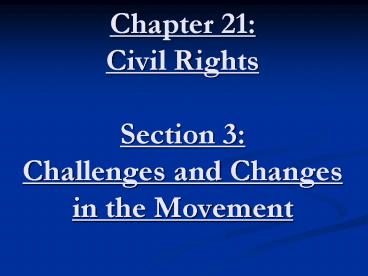Chapter 21: Civil Rights Section 3: Challenges and Changes in the Movement - PowerPoint PPT Presentation
1 / 14
Title:
Chapter 21: Civil Rights Section 3: Challenges and Changes in the Movement
Description:
.4 Examine the roles of civil rights advocates (e.g., A. Philip Randolph, Martin Luther King, Jr., Malcom X, Thurgood Marshall, James Farmer, Rosa Parks), ... – PowerPoint PPT presentation
Number of Views:839
Avg rating:3.0/5.0
Title: Chapter 21: Civil Rights Section 3: Challenges and Changes in the Movement
1
Chapter 21Civil RightsSection 3Challenges
and Changes in the Movement
2
- California Academic Standards 11.10.4 11.10.5
11.11. 5 - 11.10 Students analyze the development of federal
civil rights and voting rights. - .4 Examine the roles of civil rights advocates
(e.g., A. Philip Randolph, Martin Luther King,
Jr., Malcom X, Thurgood Marshall, James Farmer,
Rosa Parks), including the significance of Martin
Luther King, Jr. 's "Letter from Birmingham Jail"
and "I Have a Dream" speech. - .5 Discuss the diffusion of the civil rights
movement of African Americans from the churches
of the rural South and the urban North, including
the resistance to racial desegregation in Little
Rock and Birmingham, and how the advances
influenced the agendas, strategies, and
effectiveness of the quests of American Indians,
Asian Americans, and Hispanic Americans for civil
rights and equal opportunities. - 11.11 Students analyze the major social problems
and domestic policy issues in contemporary
American society. - .5 Trace the impact of, need for, and
controversies associated with environmental
conservation, expansion of the national park
system, and the development of environmental
protection laws, with particular attention to the
interaction between environmental protection
advocates and property rights advocates.
3
- Objectives
- Following lecture and reading of this section,
students will be able to - Compare segregation in the North with segregation
in the South - Name leaders who shaped the Black Power movement
- Describe reaction to the assassination of Martin
Luther King Jr. - Summarize the accomplishments of the civil rights
movement
4
- What was segregation like in the North vs. the
South? - In the mid-1960s, differences over tactics create
divisions in the civil rights movement - While still sharing the goals of racial equality
and greater opportunity, civil rights groups
began to drift apart as new leaders emerged and
turned attention atrocities in the North
5
- The problem in the North was de facto segregation
(Segregation that exists by practice and custom,
harder to fight than de jure segregation
segregation by law) - De facto segregation is harder to fight because
eliminating it requires the transformation of
racist attitudes rather than the repeal of Jim
Crow Laws. - Activists would find it much more difficult to
convince whites to share
6
- economic and social power with African Americans
than to convince them to share lunch counters and
bus seats - In the North, de facto segregation traps many
African Americans in decaying slums, as white
flight sees many whites move to suburbs because
of the influx of African Americans moving into
the city
7
- Landlords refused to comply with housing and
safety ordinances, schools and neighborhoods
deteriorated, unemployment rose among African
Americans, police brutality grew tired - Urban riots reveal that many African Americans
suffer economic and political inequality - Harlem riot sparked after 15 year old African
American killed in clash with police
8
- The Watts riots broke out in Los Angeles in 1965,
30 million in damages, 34 deaths - Over 100 cities erupted in riots and whites could
not understand why blacks would turn to violence
after winning so many civil rights victories - Some white leaders realized African Americans
wanted and needed economic equality of
opportunity in jobs, housing, and education
9
- In 1964 before the riots began LBJ announced his
plans of a war on poverty and the Great Society
MLK Jr. claimed that the Great Society had been
shot down on the battlefields of Vietnam - Who were the leaders that shaped the Black Power
movement? - Malcolm X appeals to a growing sense of African
American pride, and those African Americans who
believe they should take complete control of
10
- their communities, livelihoods, and cultures
- Malcolm X (Little) was jailed at age 20 for
burglary, and while in prison studied the
teachings of Elijah Muhamed, the head of the
Nation of Islam, or the Black Muslims - Malcolm dropped Little believing it was his slave
name, became a minister in 1952 of the Islamic
religion, and became a famous disciple
11
- He preached whites were cause of the condition
blacks found themselves in and they should
separate from white society - He got a lot of publicity for his views (1) call
for armed self-defense (2) resentment of other
members of Nation of Islam - Malcolm X departed from his practice with
Muhammad over differences in strategy and doctrine
12
- He went to Mecca, a trip required of orthodox
Muslims, there he radically change his view after
hearing of the equality of the races. - His later efforts to temper African-American
separatism alienated many Black Muslims, three of
whom assassinate him on February 21, 1965 - Group work I am going to assign six groups with
six people in each group
13
- 1 person will be the recorder
- 3 people will be researchers and consultants
- 1 will be an artistic consultant and
- 1 will be the illustrator
- You will be turning in your researched
information with all group members names on it,
and an illustration. - Two people from your group will present, the
recorder will present the information from your
sub-section,
14
- and the consultant will present the illustration
- You will have about 12-15 minutes to have
everything completed and ready to present - Presenters will come up to the front of the room.
- Presentations should take about 1-2 minutes each
- Any Questions?
- GO

